Meet David Steinman, an environmental activist, investigative journalist, and author who has worked to expose…
The post Best of Earth911 Podcast: Author David Steinman on Raising Healthy Kids In a Toxic World appeared first on Earth911.

Meet David Steinman, an environmental activist, investigative journalist, and author who has worked to expose…
The post Best of Earth911 Podcast: Author David Steinman on Raising Healthy Kids In a Toxic World appeared first on Earth911.
David Katz, founder and CEO of Plastic Bank, returned to talk with Mitch Ratcliffe about…
The post Best of Earth911 Podcast: Plastic Bank’s David Katz On Building A Global Bottle Deposit System appeared first on Earth911.
When e-cigarettes, or vapes, came on the market in 2007, they were initially seen as…
The post Recycling Mystery: Vapes and Vaping Products appeared first on Earth911.
When China’s plastic ban took effect in January 2018, recycling centers in Boise, Idaho, were…
The post Hefty ReNew Program: Still Working to Keep Plastics Out of Landfills appeared first on Earth911.
Electric toothbrush heads might be small, but they can make a big impact on our…
The post How to Recycle Electric Toothbrush Heads appeared first on Earth911.
The northern lights, or aurora borealis, can be seen throughout the polar north, but the most vivid displays occur under an oval-shaped ring, the aurora oval, that circles the magnetic North Pole.
The aurora oval stretches across northern parts of Alaska, Canada and Greenland, as well as over Iceland, northern Scandinavia (Norway, Sweden and Finland), and parts of Russia. Within the oval, solar particles interact with the Earth’s magnetic field, creating the vibrant aurora borealis displays.
Churchill, Manitoba, sits within the aurora oval on Hudson Bay and at the mouth of the Churchill River. Nat Hab’s Northern Lights Photo Expedition in Churchill offers an exclusive opportunity to photograph this elusive light display, alongside the snowy landscapes and wildlife that define Churchill. With expert photography guides, you’ll capture unforgettable images of the aurora far from city lights, beneath the vast arctic skies.
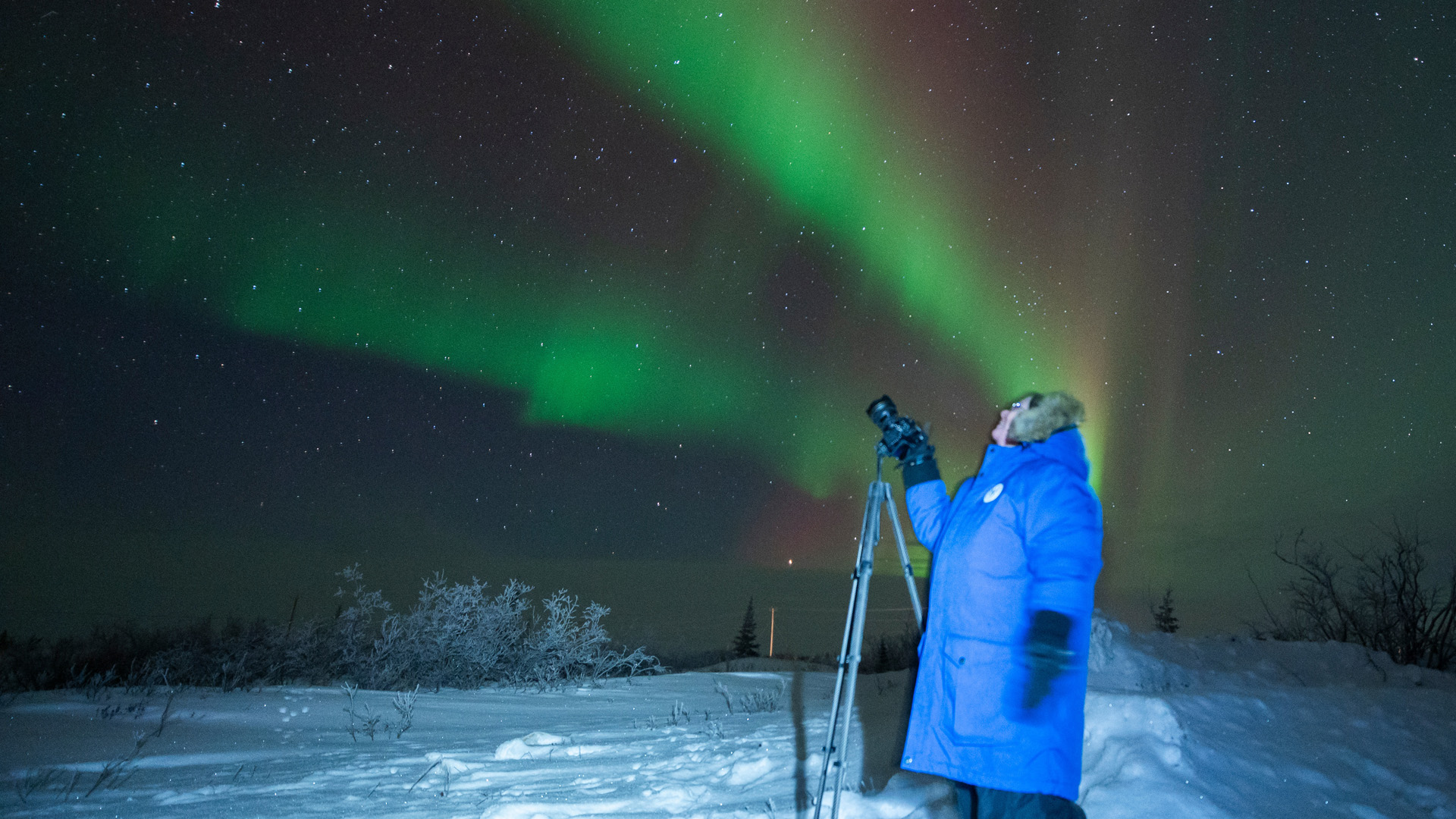
Photographed by Nat Hab Expedition Leader © Eddy Savage
Nat Hab Expedition Leader and Chief Sustainability Officer Court Whelan says, “We are in a beautiful location in Churchill, Manitoba, what I view as one of the best places for aurora viewing and, of course, aurora photography in the entire world.”
We’ve assembled numerous tips, stories and guides for getting great shots of the northern lights. You can see many of those here. In this article, we combine them for six iconic shots to aim for on your Northern Lights & Arctic Exploration Adventure.
Just as a commercial photographer has a shot list for the images to capture during a work day, so too you might want to think before your arrival about the kinds of images you want to be able to return home with.
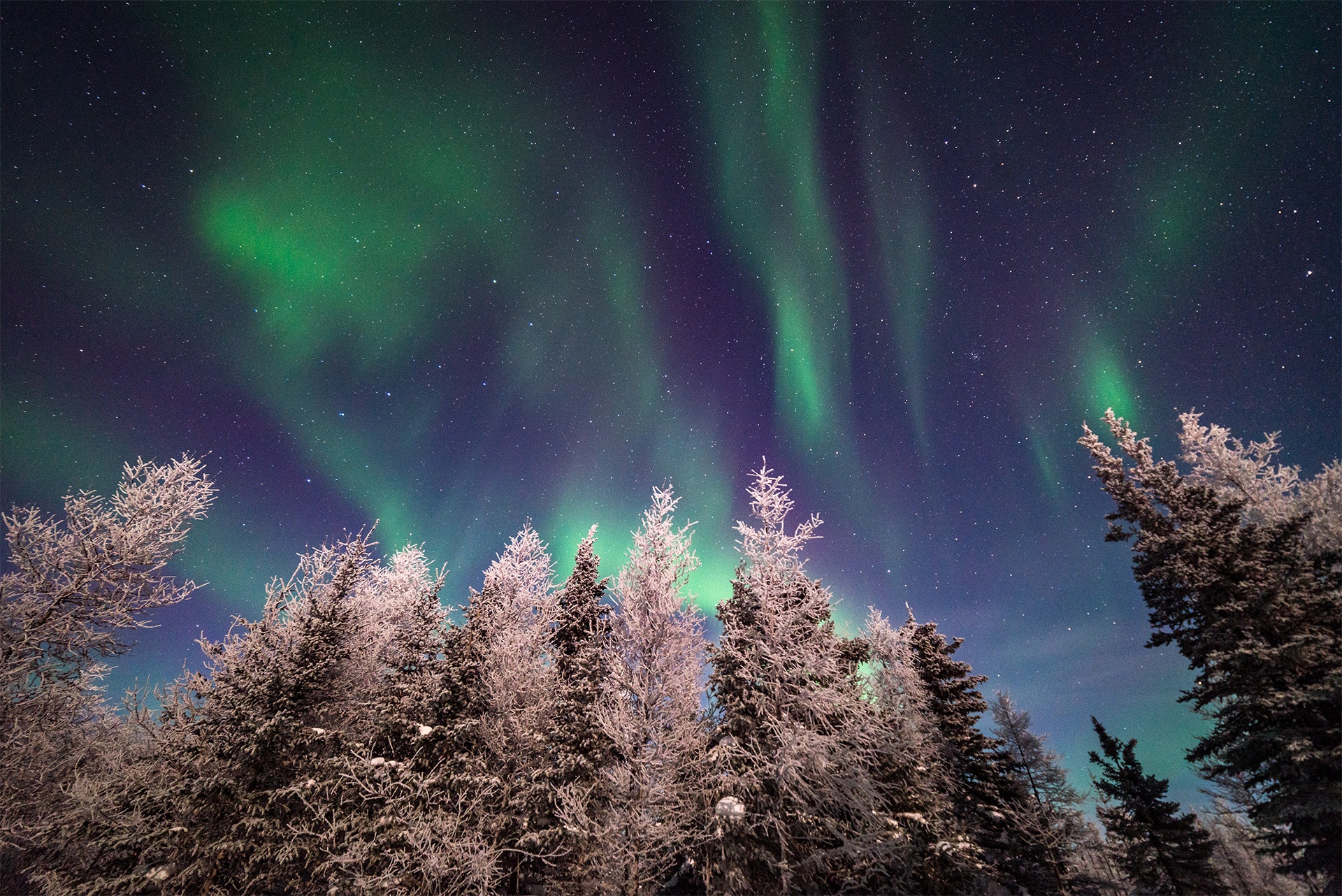
© Eddy Savage
Here are six iconic shots to aim for on your Northern Lights Photo Expedition in Churchill:
Court says, “We’re in a beautiful part of Churchill, which is the boreal forest. One of the most known and revered things about Churchill is its confluence of these major biomes. We’ve got the tundra, the arctic tundra, just a little further out there, but right now, we’re tucked in this beautiful boreal forest. So we see these incredible black and white spruce trees all around us. This is the ideal thing for foreground elements in aurora photography.”
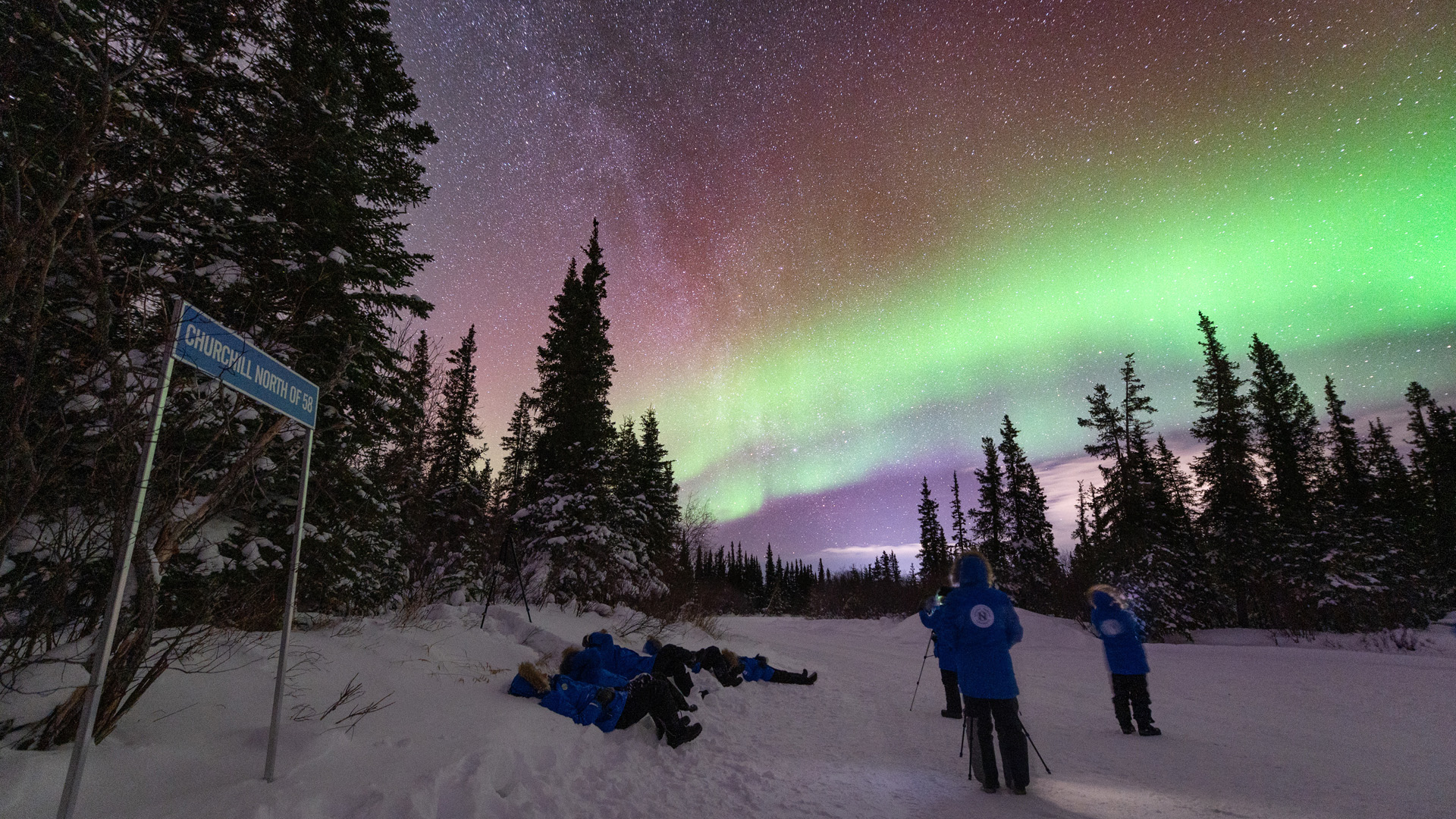
Nat Hab Expedition Leader © Eddy Savage
Churchill’s boreal forest provides an ideal foreground for photographing the northern lights. The stark beauty of snow-covered black and white spruce trees adds depth and context to your images of the aurora borealis, making it more than just a “green swash across the sky.”
The clear, dark skies, far from any light pollution, make Churchill a prime location for capturing the stunning natural display of the aurora.
For your first iconic shot, focus on the northern lights illuminating the sky over the snow-covered spruce trees of the boreal forest. Use a wide-angle lens to capture the full scope of the lights as they ripple and dance above the trees. A long exposure will bring out the vivid greens, purples and blues of the aurora while maintaining the contrast of the dark, snow-draped trees below.
Nat Hab Expedition Leader Court Whelan emphasizes the importance of including foreground elements in aurora photography: “Without some sort of context like a foreground—some snow, some trees, a building or an igloo—it’s going to look a little uninviting and not that interesting.”
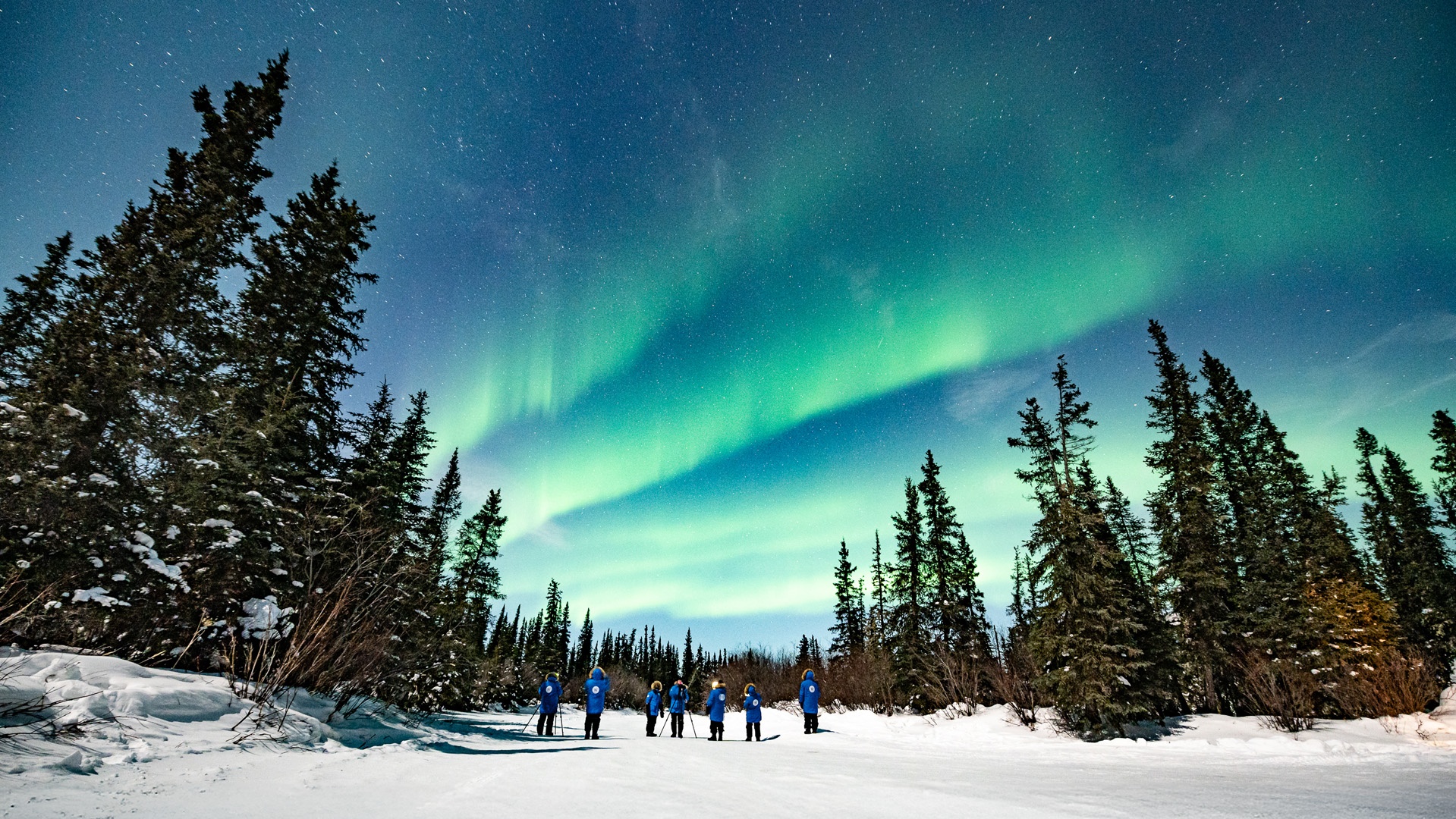
Nat Hab Expedition Leader © Eddy Savage
Trees in the foreground help in multiple ways:
Tip: “One of the most challenging things about aurora photography is where and how to focus.” Framing the lights with the towering trees adds context and enhances your composition, transforming the shot into a captivating scene.
Resource: For more on choosing the right foreground for your northern lights photography, check out Court Whelan’s blog post: How to Pick Your Foreground for Northern Lights Photography.
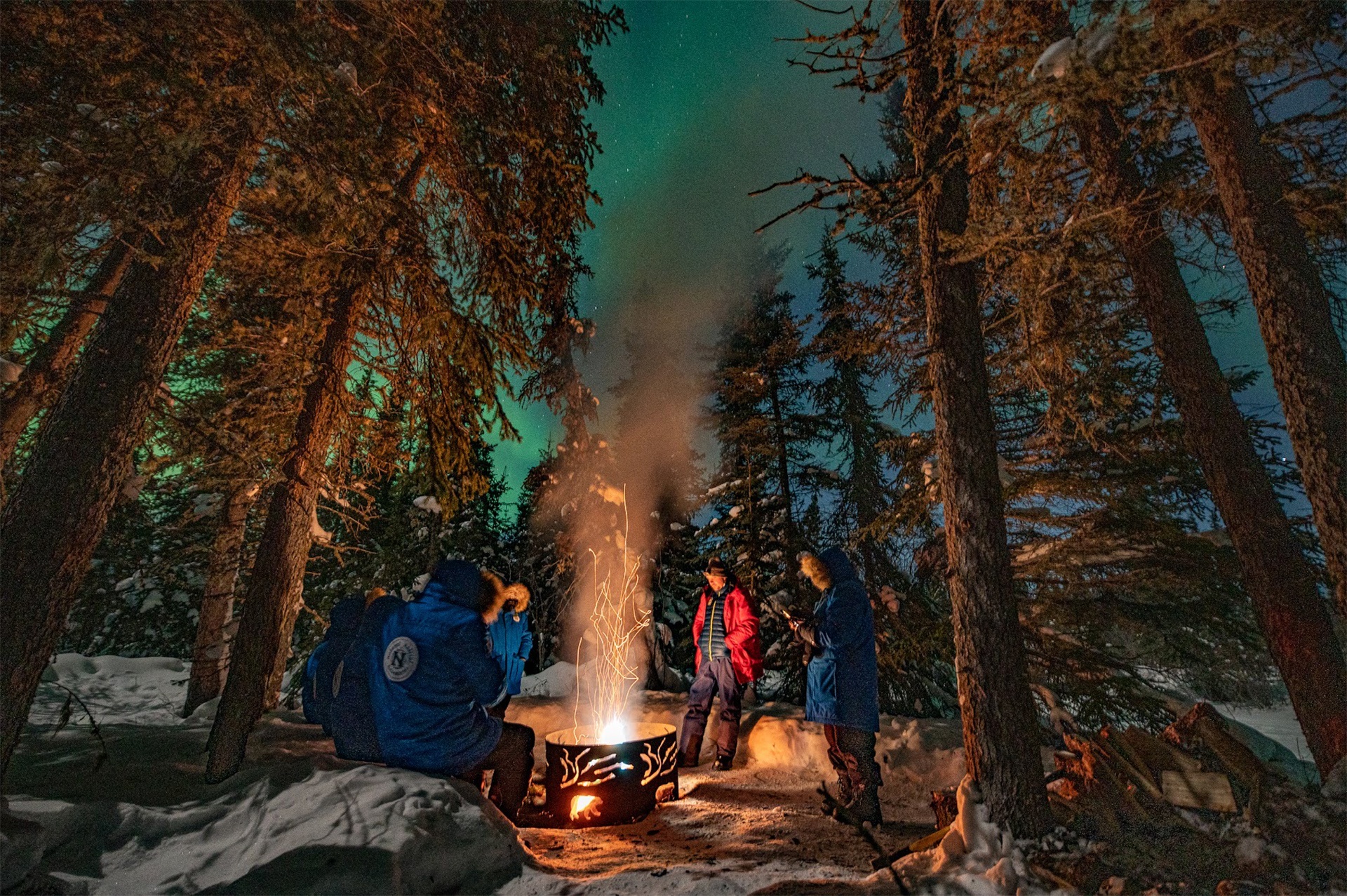
Nat Hab Expedition Leader © Eddy Savage
The frozen landscape of Churchill provides a perfect reflective canvas for the northern lights. The ice-covered terrain creates stunning reflections of the vibrant aurora borealis, adding an extra layer of visual interest to your shots. This pristine wilderness setting in northern Manitoba offers some of the clearest views of the northern lights thanks to its remote location and the extended winter nights.

For your second iconic shot, focus on the reflection of the northern lights on the ice. Position yourself to incorporate both the lights in the sky and their reflection on the icy surface.
Tip: A long exposure shot will highlight the vibrant colors of the aurora and the subtle texture of the frozen landscape, creating a stunning mirror effect that captures the tranquility of the arctic night.
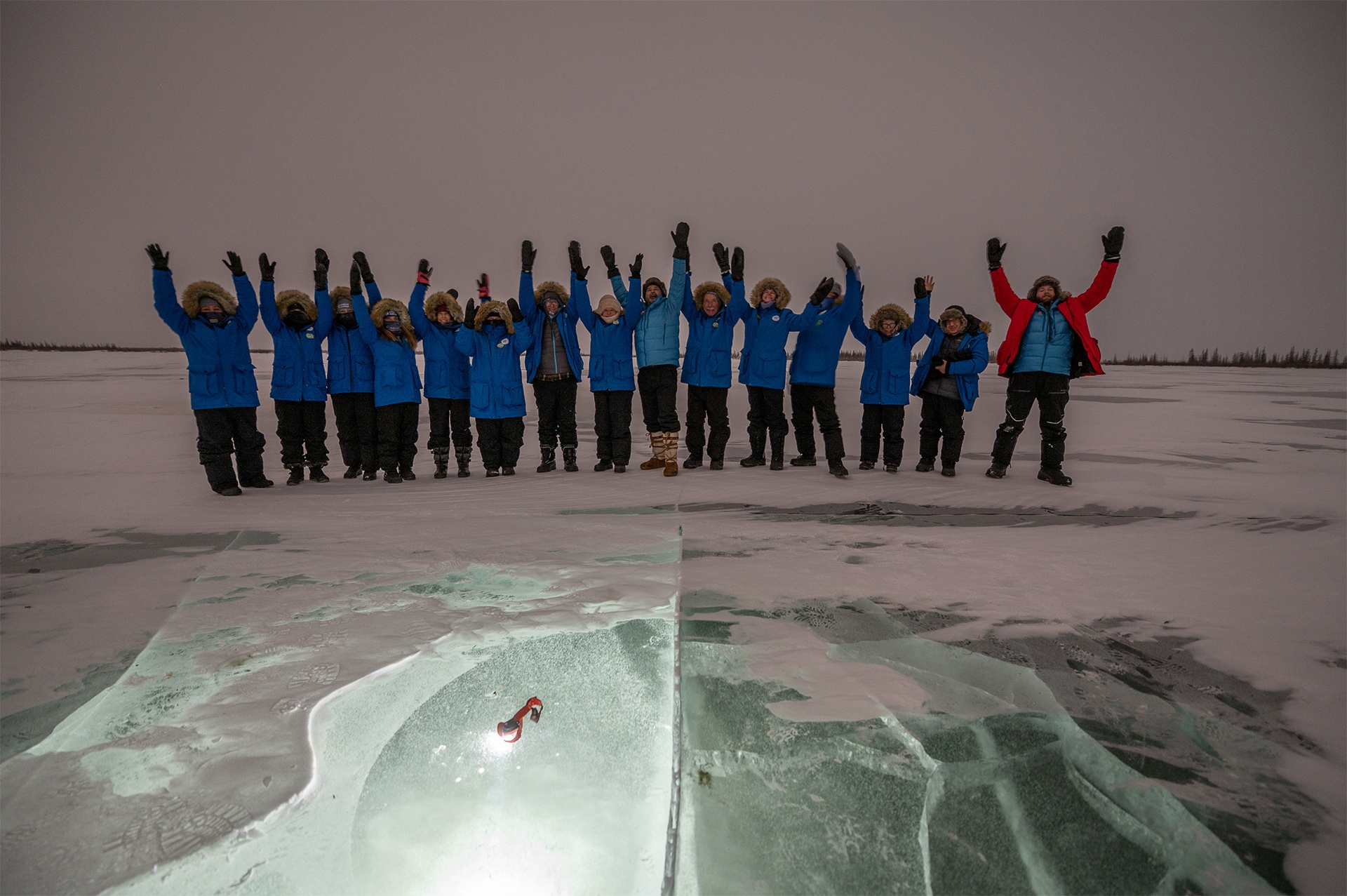
© Eddy Savage
As Court Whelan advises, “A long exposure allows the aurora to paint the sky in brilliant hues,” so make sure to experiment with exposure times to find the perfect balance between capturing the movement of the lights and the stillness of the ice.
Resource: For more ideas and techniques, refer to Nat Hab’s guide: Photographing the Northern Lights.
Churchill is rich in history, with structures that add a distinct sense of place to your photos. Old cabins, stone structures, and even relics of arctic exploration provide an interesting contrast to the natural beauty of the aurora. Including man-made elements adds storytelling and a sense of human connection to your northern lights photography.
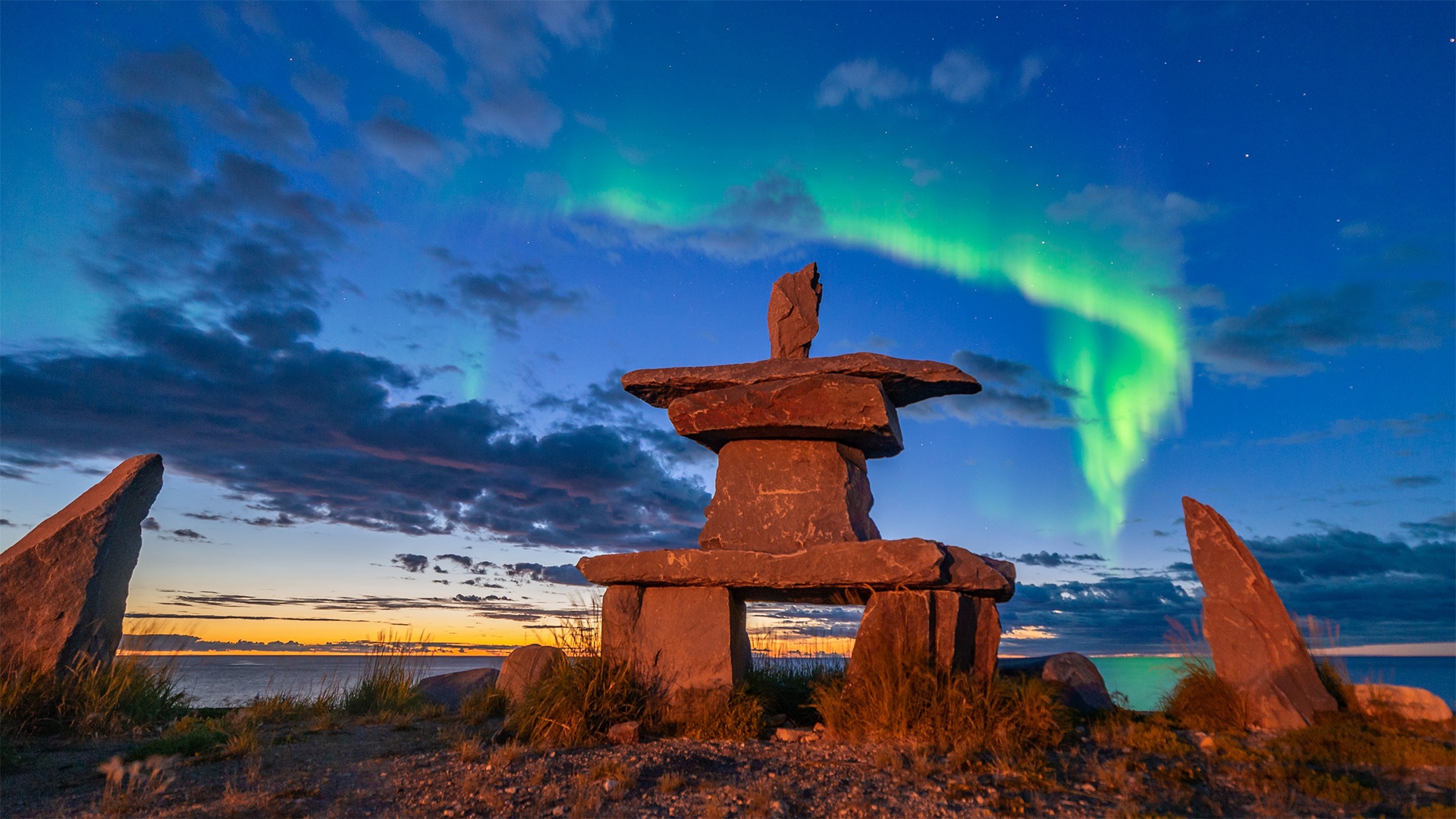
Inuit Inukshuk on the shore of Hudson Bay. Photographed by Nat Hab Expedition Leader © Eddy Savage
For your third iconic shot, capture the northern lights framed by Churchill’s historic structures. The contrast of man-made elements against the wild arctic landscape, illuminated by the shifting colors of the aurora, creates a powerful narrative in your photographs. Whether it’s a weathered cabin or an old arctic vehicle like the Bombardier, these elements bring an authentic, human touch to your aurora images.
Court Whelan emphasizes the value of having clear foreground elements in your northern lights shots: “Having something to focus on in the foreground, like trees or historic structures, makes the photo look crisp and adds a storytelling element.”
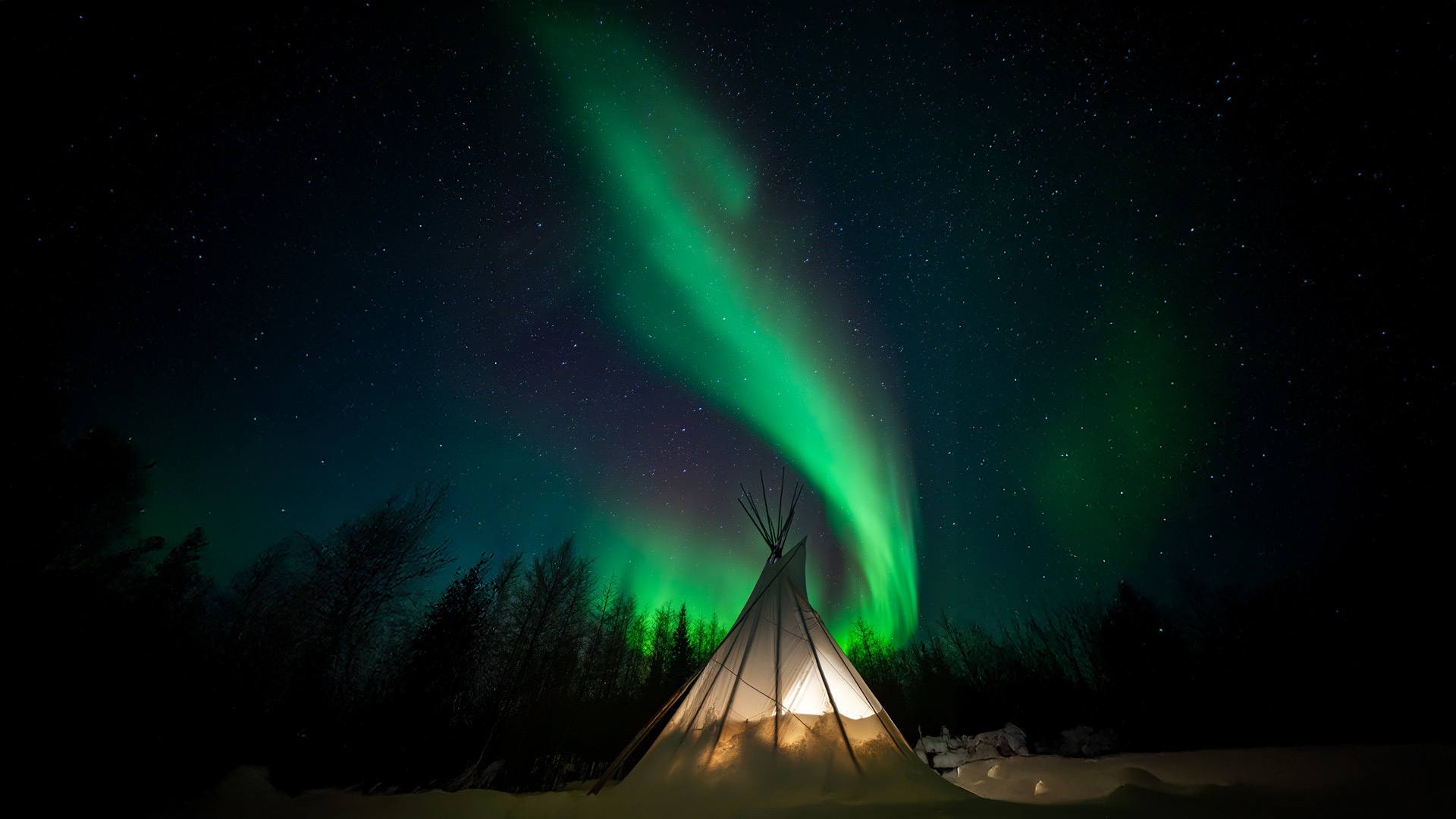
Nat Hab Expedition Leader © Sabina Moll
Tip: Use structures to anchor your images and enhance the composition of your aurora photography.
Though the northern lights are the expedition’s main attraction, Churchill’s arctic landscape is also home to a variety of wildlife, including Arctic foxes and snowy owls. These animals offer fantastic photo opportunities during the daytime.

Arctic fox
For your fourth iconic shot, focus on wildlife in the snowy arctic landscape. Capture an Arctic fox against the backdrop of the boreal forest, or photograph a snowy owl perched on a snowbank, with the soft daylight casting a natural glow on the scene. These wildlife images, paired with your nighttime aurora shots, will create a well-rounded collection from your Churchill expedition.
Wide-angle landscape shots that include wildlife as part of the larger scene can emphasize the vastness of the Arctic, while close-up portraits highlight the animals’ unique adaptations to the extreme environment.
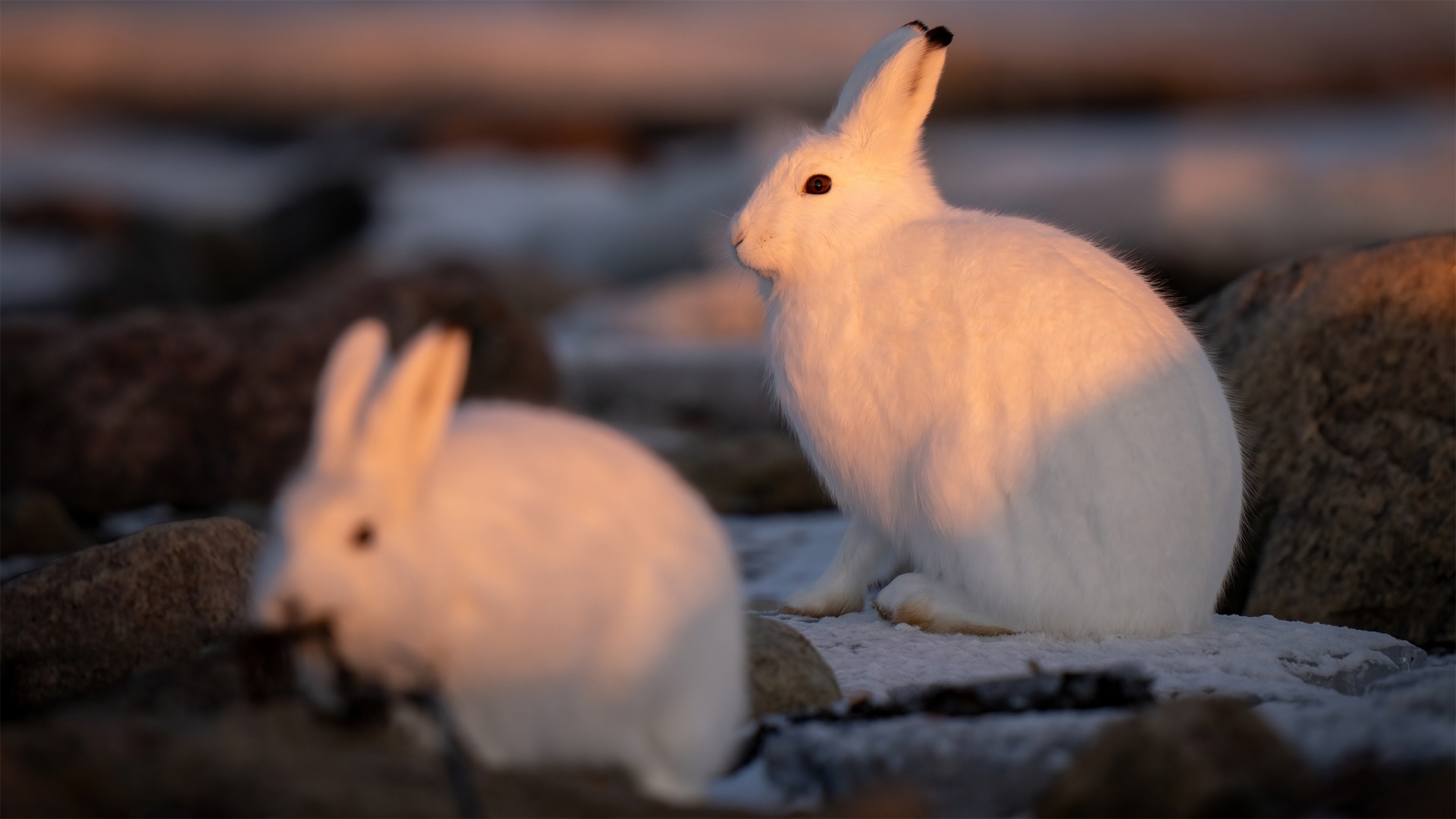
Arctic hare
Resource: Check out Court’s Guide to Capturing “Everything Else” on a Northern Lights Expedition.
The open tundra surrounding Churchill offers unobstructed views of the northern lights, making it a great location to capture the full majesty of the aurora. The tundra’s flat, snow-covered expanse provides a dramatic setting for long-exposure photography.
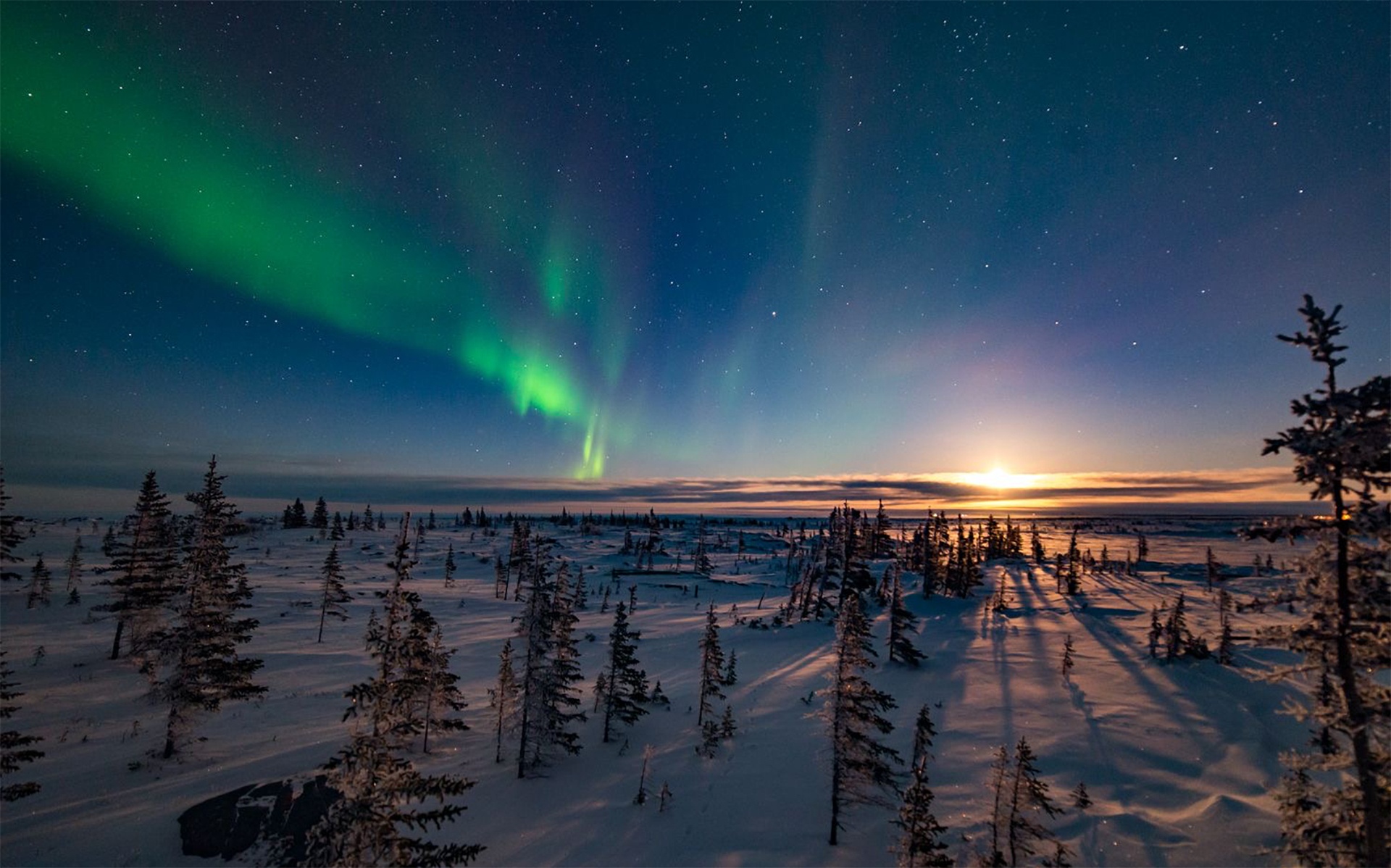
© Eddy Savage
For your fifth iconic shot, focus on the northern lights over Churchill’s wide-open tundra.
Tip: Set up your camera to capture the full scope of the lights dancing across the sky, with the snowy tundra stretching out beneath. The stark, barren landscape emphasizes the isolation and beauty of the aurora, creating a visually stunning and emotionally impactful image.
Court says, “Every second’s a little bit different when shooting the aurora,” so be prepared to capture the lights at different intensities and movements, from serpentine curtains to bright, waving streaks.
Resource: This might be a great time to capture a shot of your group, too. Here’s Court’s tutorial on How to Get a Group Shot in front of the Aurora Borealis.
One unique aspect of the Churchill expedition is the opportunity to incorporate light painting into your northern lights photography. Using a flashlight, you can illuminate foreground elements like historic arctic machines—such as the Bombardier snow vehicle—while capturing the northern lights in the background.
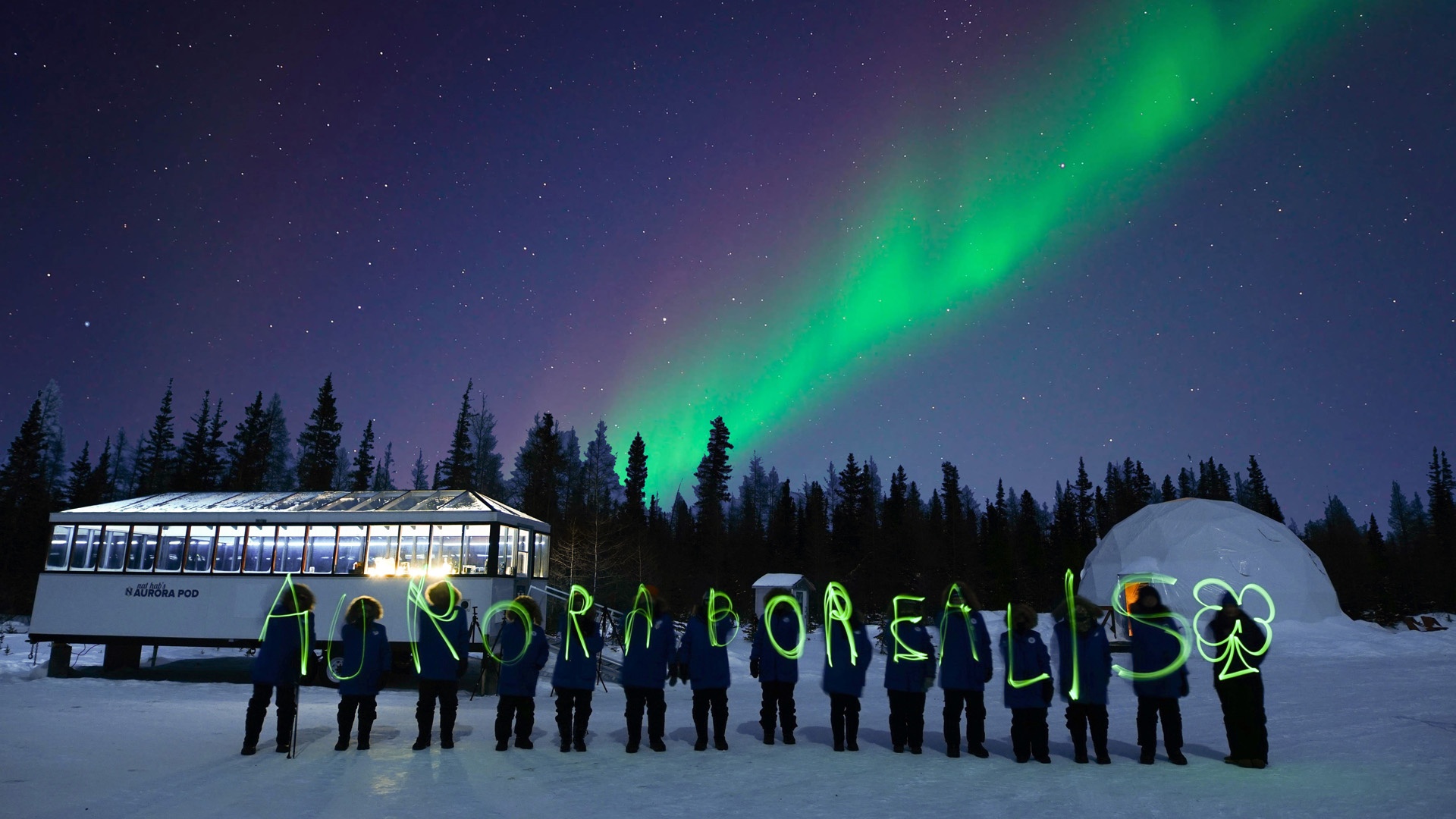
Light painting with our guests! Photographed by Nat Hab Expedition Leader © Petr Gheorghe
For your sixth iconic shot, focus on light painting arctic relics under the northern lights. By briefly illuminating the Bombardier snow vehicle or another historic machine with a flashlight, you can highlight the texture and details of the vehicle without overwhelming the night scene.
The key is to balance the artificial light with the natural glow of the aurora and stars. Court shows how in this video, How to Take Amazing Northern Lights Photos:
Tip: A subtle touch of light can add depth to your photo while maintaining the focus on the northern lights above.
Resource: For more inspiration and advice on photographing the aurora in remote locations, check out Nat Hab’s Northern Lights Video Tutorial.
Churchill, Manitoba, offers a rare and unforgettable opportunity to photograph one of the world’s most awe-inspiring natural phenomena—the northern lights. From the shimmering lights over boreal forests and reflections on the ice to wildlife encounters and historic relics under the aurora, this expedition provides countless opportunities for stunning photography.
With the best viewing typically between November and March, the longer winter nights in Churchill provide a perfect setting for aurora borealisphotography. You’ll be in a region known for its exceptional northern lights displays, far from light pollution, with dedicated nighttime excursions designed to maximize your viewing opportunities.
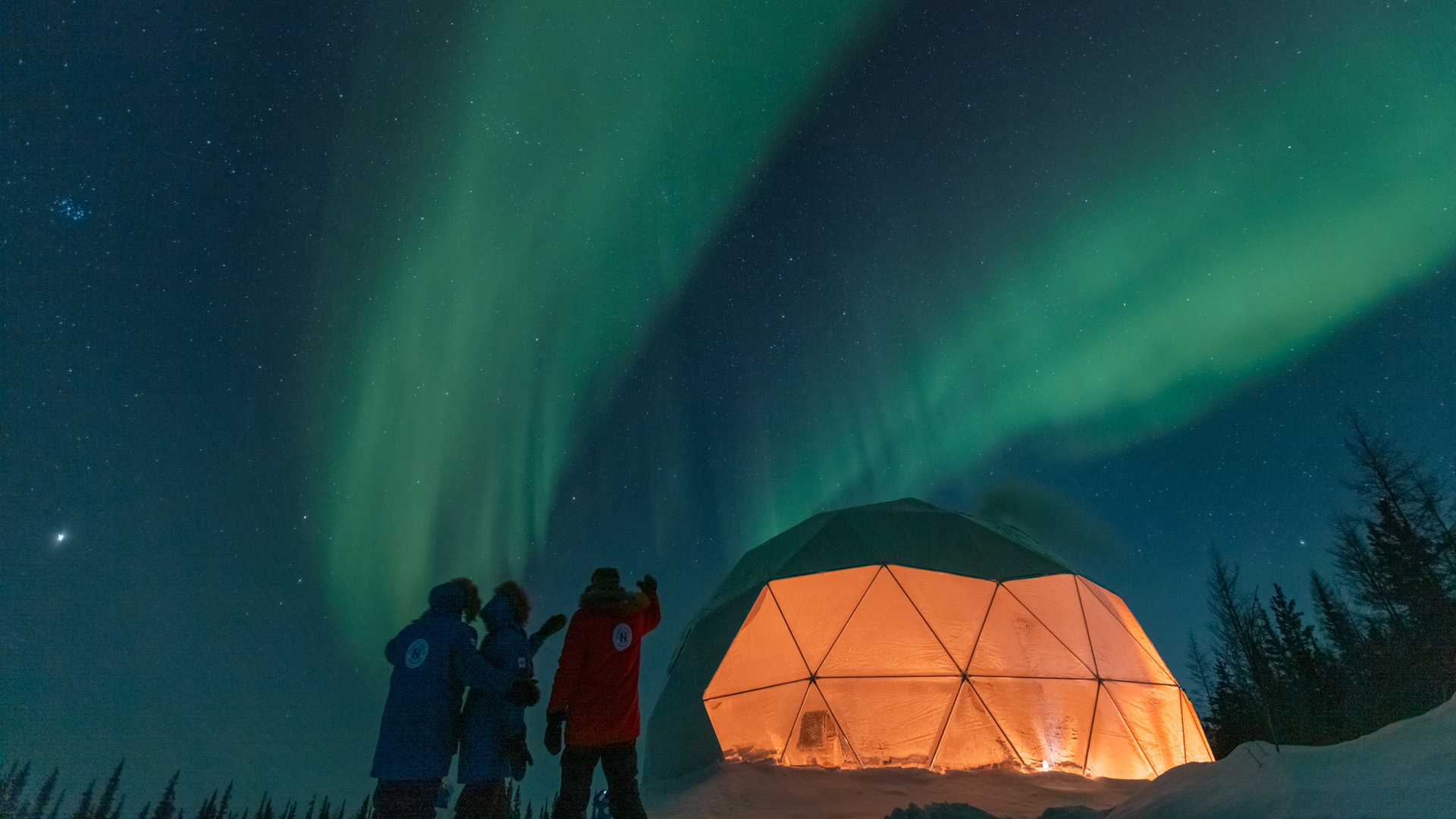
Nat Hab’s Aurora Sphere: one of our custom Northern Lights Viewing Locations. Photographed by Nat Hab Expedition Leader © Giulia Ciampini
To prepare for your winter arctic journey, explore
For further insights into Churchill and the Arctic region, explore WWF’s resources:

Nat Hab guests inside our custom Aurora Dome © Alexander de Vries
The post 6 Iconic Northern Lights Photos to Capture in Churchill, Manitoba first appeared on Good Nature Travel Blog.
Humans create a lot of waste, but when you throw something away, how much do…
The post Understanding Where Garbage Goes appeared first on Earth911.
With its bulbous shape and a canopy that resembles an upside-down root system, the baobab tree is an iconic symbol of the African continent. Its origins are also the stuff of legend…literally. Along the Zambezi River, some tribes believed that one day their gods became angry, ripped the baobab from the ground, and tossed it up into the air, resulting in its inverted-like appearance. In another tale, God gifted the baobab to a hyena. However, the hyena felt so repelled by the tree’s already unusual exterior, he shoved it to the ground upturned.
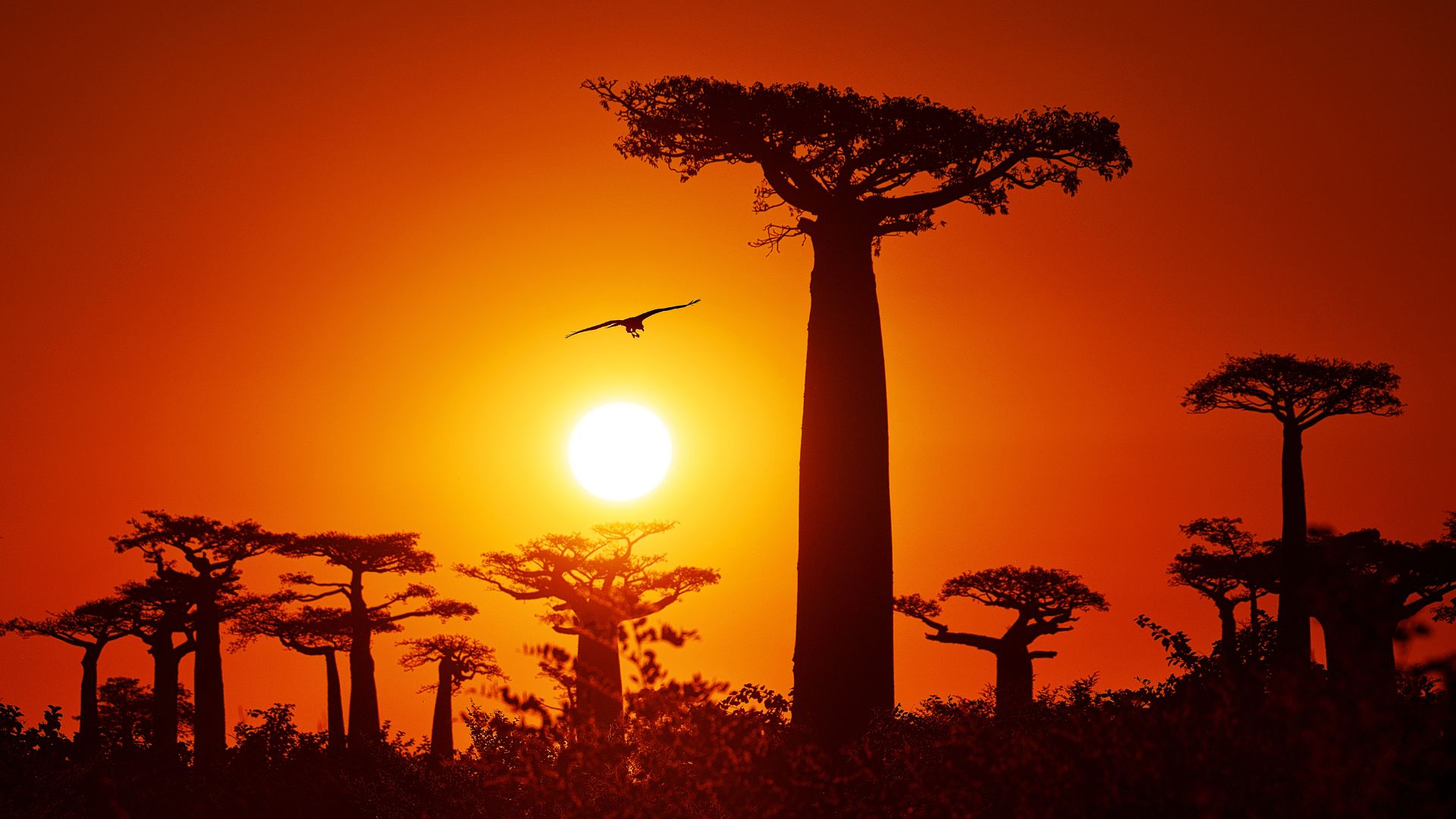
© Justin Jin / WWF France
Whatever way the baobab came to be, it’s undoubtedly a remarkable specimen. Baobabs can grow up to 100 feet tall, have a circumference of as much as 165 feet, and live as long as 3,000 years. These solitary trees are also incredibly resilient, thriving in dry, open areas such as the savannas of southern Africa and western Madagascar, and surviving by storing water in their massive trunks.
Their thick bark protects them from bushfires, while their massive root systems help slow soil erosion and aid in the recycling of nutrients. Baobabs may depend on pollinators like fruit bats and bush babies to reproduce, but the trees themselves are incredibly regenerative. They can even create new bark when needed, healing wounds that would take other trees down.
Then there’s the baobab’s fruit: a woody round or egg-shaped pod that can grow up to a foot long and hangs from the tree’s branches courtesy of a long, thick stalk. Its pulpy interior is loaded with seeds and brimming with nutrients, including tartaric acid—a natural antioxidant—and loads of Vitamin C.
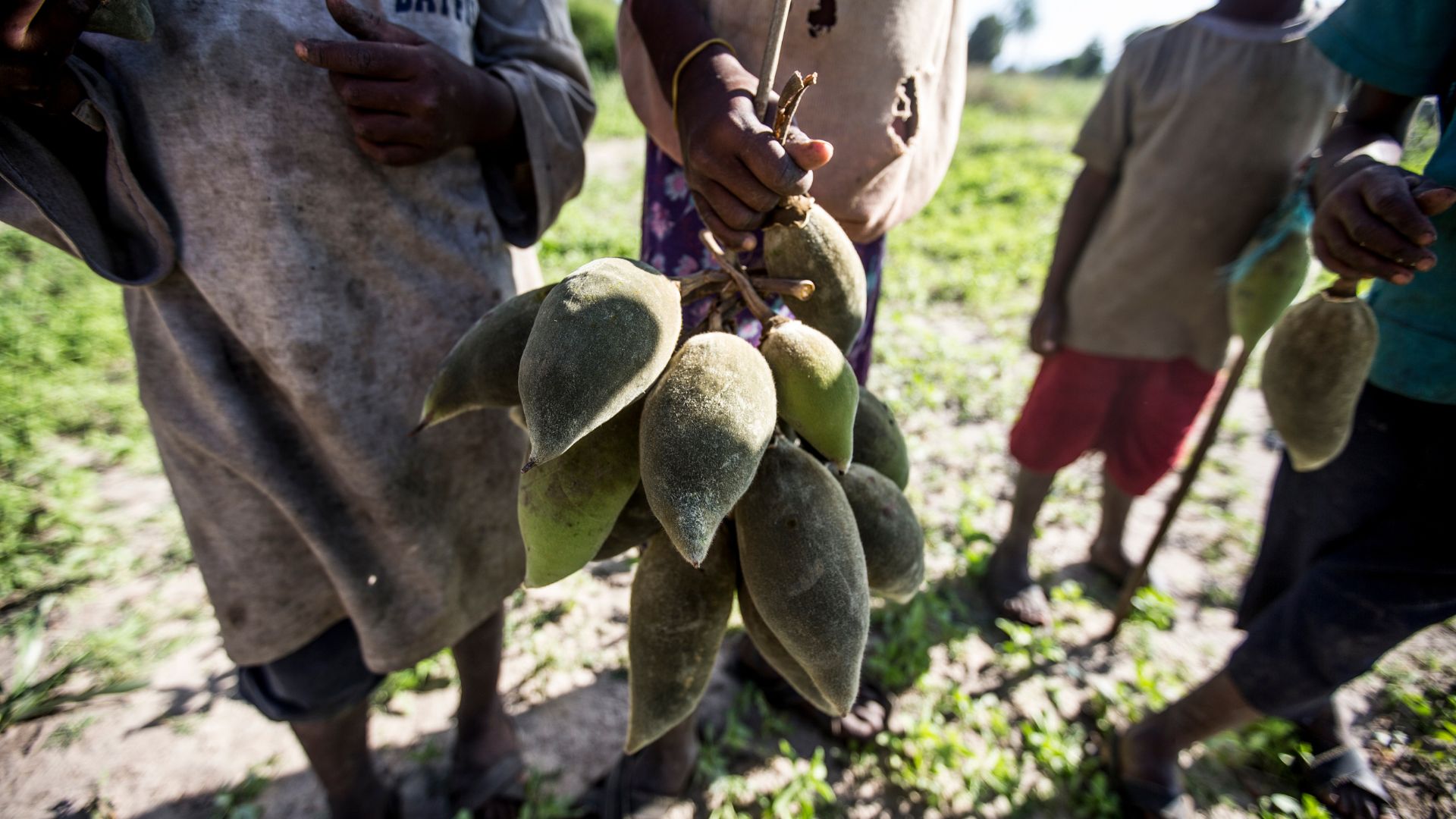
© James Morgan / WWF-US
Native to sub-Saharan Africa, the southern Arabian Peninsula (Yemen, Oman), and Australia, baobabs consist of 9 species. While the African continent is home to two different kinds, six are endemic to Madagascar, and Australia has one type of baobab. The latter is commonly known as the ‘boab’ among Aussies and thrives in both Western Australia’s Kimberly region and the country’s Northern Territory.
Baobab trees are nicknamed “The Tree of Life,” and for good reason. Between just the bark and fruit alone, baobabs offer more than 300 vital uses. While elephants quench their thirst on the tree’s water-rich interior, they also snack on its produce and then fertilize the local soil through their droppings. Baboons crack open the fruit’s hard exterior and fill up on its pulpy seeds (leading to the baobab’s other moniker, the ‘monkey bread tree’).
Marabou storks and red-billed buffalo weavers nest in their branches, and fruit bats and bush babies—as well as lemurs in Madagascar—sip up the nectar from their blossoms, pollinating one flower to the next as it goes. These large white blooms spread their petals at night and flower for no more than 24 hours. They typically spring to life during or after the rainy season.
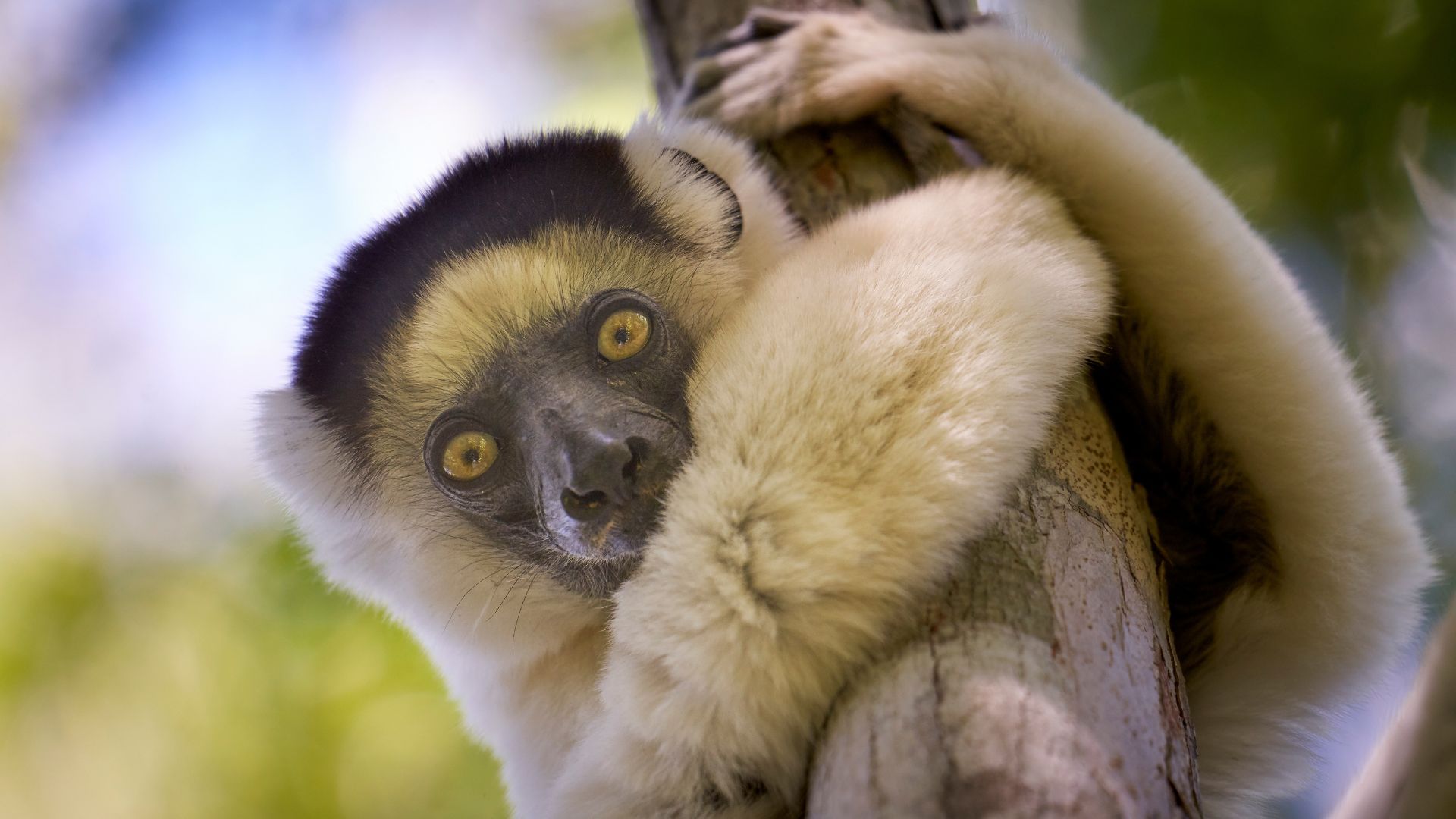
© Justin Jin / WWF France
As much as wildlife depends on the baobab tree (and vice-versa), so do humans. Not only is the fruit’s sour brown pulp edible and nutritious, but soak it in water and it becomes a refreshing drink. People who live around baobab trees will roast and grind its fruits’ seeds to produce a beverage akin to coffee, or boil the tree’s leaves and eat them like spinach. Not only are these leaves loaded with potassium and magnesium, but they’re often used in traditional medicine for treating ailments such as insect bites and asthma.
The tree’s bark is the basis for everything from paper and cloth to ropes and baskets. People also used it to make waterproof hats and musical instrument strings. By mixing the flower’s pollen with water, you can even create a form of glue.
The older a baobab tree gets, the more impressive it becomes. An ancient Baobab can support an entire ecosystem, from the bees and stick insects that reside among its branches, to the antelope and warthogs that delight in its fruit. In fact, baobabs are considered a keystone species, meaning they play an essential role in local biodiversity.
Despite their enormous size and longevity, baobabs are not immune to threats. Here are just some of the challenges they face (as well as some possible solutions).
Many scientists believe that climate change is killing Africa’s oldest and largest baobab trees, the result of more frequent weather anomalies like floods and lightning storms. Elephants will often damage baobabs during extreme droughts to get to their water supply, sometimes digging into the wood so severely that the tree can simply collapse.
WWF’s assessment of the vulnerability of African elephants regarding climate change shows that their biggest concern is having enough fresh water. Creating safe wildlife corridors is one way to increase an elephant’s source options, and relieve pressure on individual baobab trees in the process.
Madagascar, which is home to six of the world’s 9 baobab species, has experienced massive deforestation, losing approximately 235 thousand hectares of tree cover from 2010 through 2021. This includes the loss of baobab habitats.
WWF’s Forest Landscape Restoration (FLR) in Africa is an initiative helping to restore forests and forest landscapes across 9 African countries, including Madagascar. One action entails working with local communities to develop commercially viable landscape restoration projects, and then connecting these community enterprises with investors and commercial partners so that they can prosper on a larger scale.
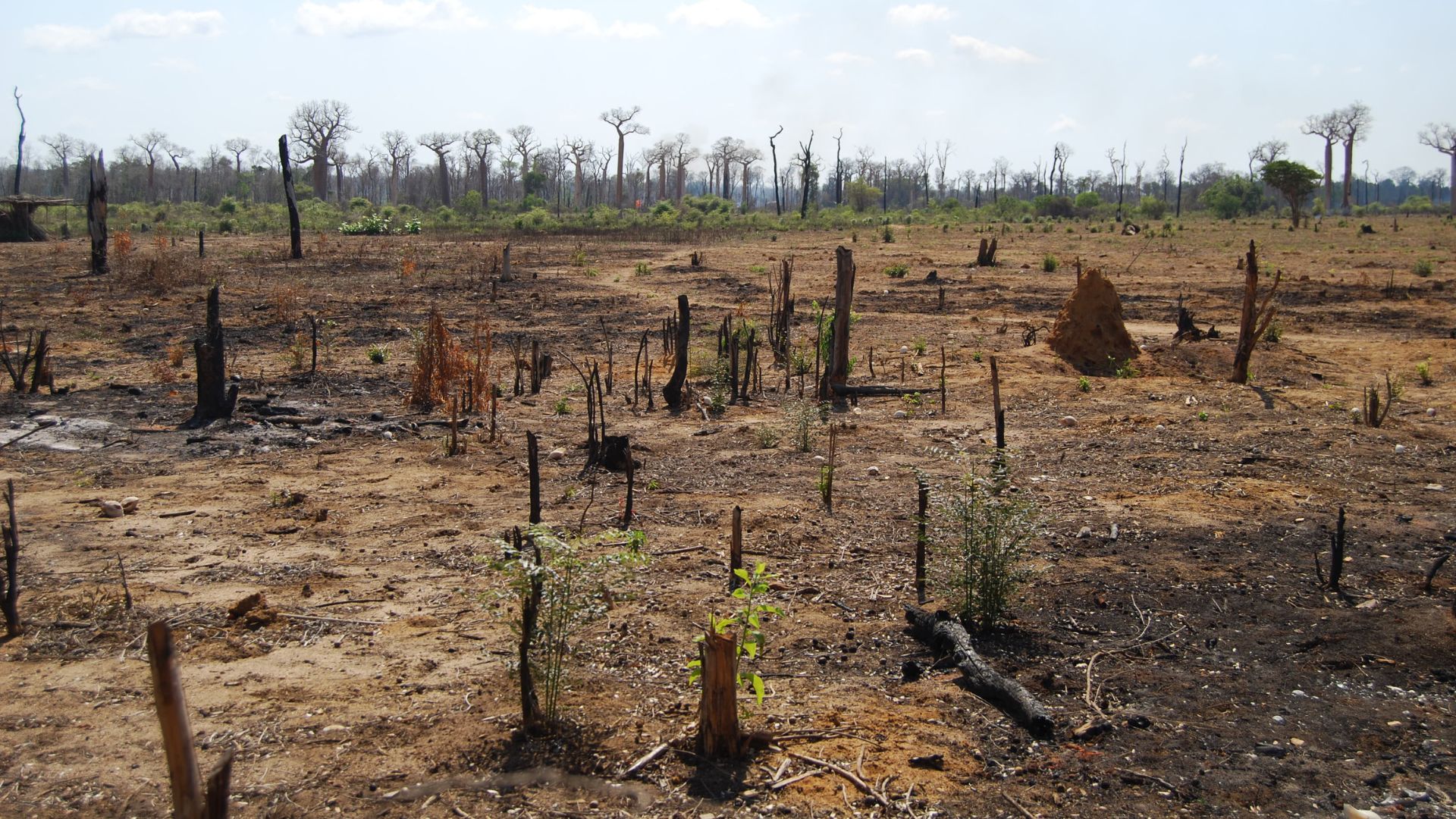
© WWF / Martina Lippuner
With their smooth bark, thick, cylindrical trunks, and flat-topped crowns, Grandidier’s baobabs are one of Madagascar’s most recognizable baobab species. It’s also a species that’s highly threatened by the conversion of local forests into agricultural land. Loss of forests can lead to extreme soil erosion, and slash-and-burn farming, as well as over-grazing, inhibit the baobab’s proper regeneration.
WWF’s work in sustainable agriculture includes creating financial incentives, which can help encourage the conservation of biodiversity in places where baobab trees grow.
While the baobab itself is iconic, here are a few that are even more beloved than most.
This especially large baobab in Zambia’s Kafue National Park is known as “the tree that eats maidens.” According to local legend, Kondanamwali fell in love with four beautiful women, who decided that they all wanted human husbands instead. The tree became jealous, so it opened its trunk and pulled the women inside, where they’re said to remain to this day.
More than two dozen towering baobabs line an 853-foot dirt stretch in western Madagascar’s Morondava. In 2007, it became the country’s first “Natural Monument.”

© Justin Jin / WWF France
South Africa’s stoutest baobab is located within Limpopo, the country’s northernmost province, and is recognizable by its humongous trunk and gnarled branches. Although researchers carbon-dated the tree at around 1,200 years old, many residents believe its age is more than twice that. It’s home to a breeding colony of mottled spinetails, a type of bird that’s most common along the West Africa coast.
The post The Baobab Tree: An African Icon and Longtime Legend first appeared on Good Nature Travel Blog.
For pet owners who are conscientious about the environment, the garbage pail may contain mostly…
The post The Poo Problem: Pet Waste appeared first on Earth911.
It was in the early morning when we first spotted Aracy, positioned near a small waterhole in Brazil’s southern Pantanal region. We followed her through the grasslands, watching the jaguar meander among trees and along the occasional dirt pathway—at one point, even walking within several feet of our open-sided 4×4 vehicle—until she spotted a herd of capybaras grazing beside a lake. “Keep quiet,” our guide Lucas whispered. “She’s about to make her move.”
In an instant, the capybaras were running into the water with Aracy sprinting behind them, hoping for an early day feast. Although luck wasn’t on her side this round, the enormous feline put on a show for the ages.
Wildlife is a given in Brazil’s massive Pantanal, a more than 75,000 square-mile UNESCO Biosphere Reserve that’s home to the largest tropical wetlands and flooded grasslands on the planet. Everything from squadrons of peccaries (hoofed mammals that resemble pigs) to alligator-like caiman call this incredible natural region—one that stretches across portions of Brazil, Bolivia and Paraguay, covering an area that’s equivalent to the size of Belgium, Holland, Portugal and Switzerland combined—home. In fact, the Pantanal hosts South America’s densest concentration of wildlife: we’re talking animals as varied as giant anteaters, musk deer, tapir and blue-and-yellow colored hyacinth macaws. Impressive, since many visitors flock to the continent’s other fauna-filled destinations, like the Amazon rainforest, without knowing that these wetlands exist.
These days, however, the Pantanal is gaining traction among wildlife lovers, thanks in large part to the efforts of Onçafari, a project established to promote conservation through ecotourism, mainly habituating jaguars to safari vehicles with the notion that the more people see these stealth cats in the wild, the more they’ll likely do something to save them.
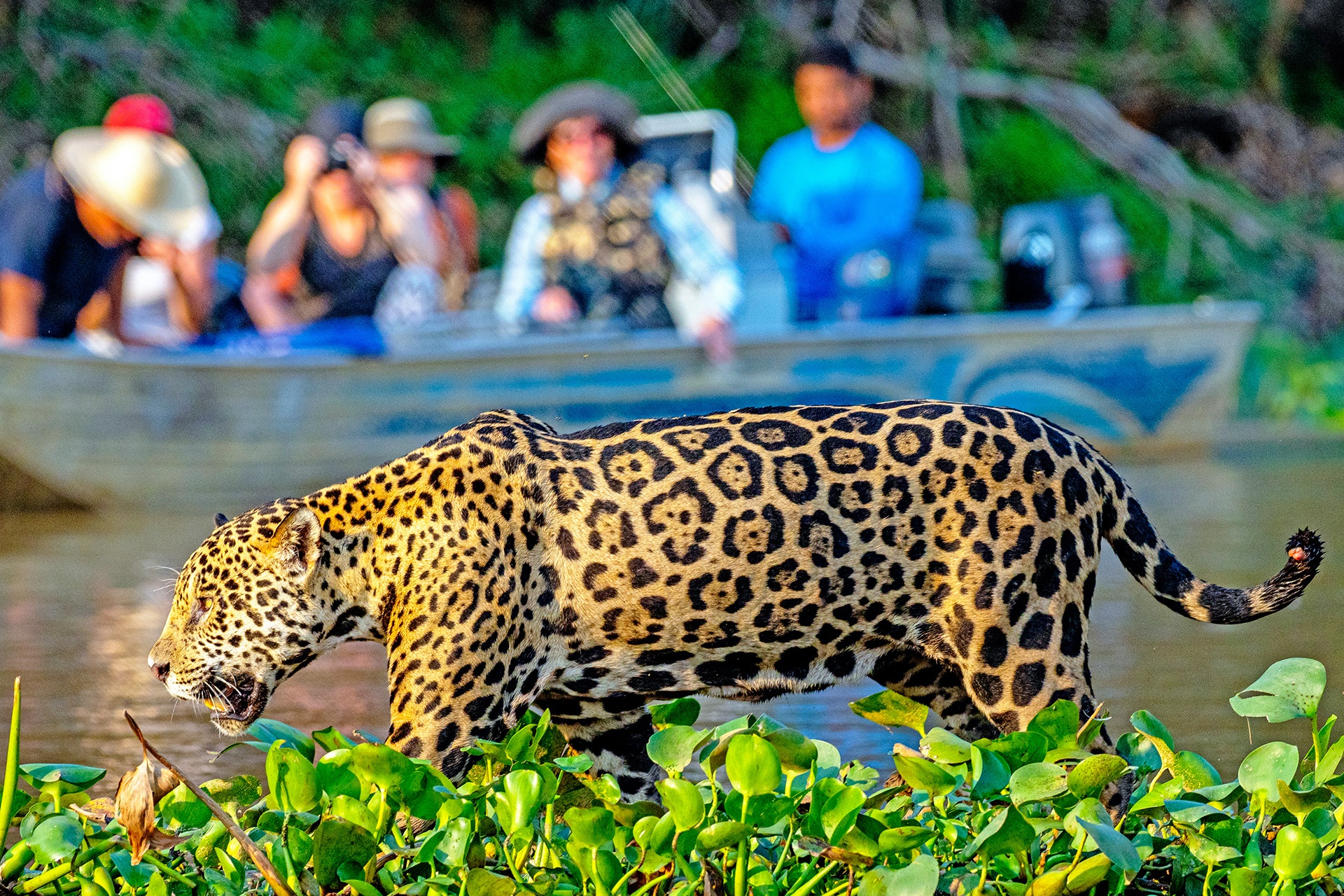
© Cassiano “Zapa” Zaniboni
Former Formula 1 racing driver Mario Haberfeld established Onçafari in August 2011. Its name is a combination of “onça,” the Portuguese word for jaguar, and “safari,” which means journey in Swahili. Haberfeld was inspired to start the project after visiting the African continent, where wildlife such as lions, elephants, and hyenas have grown up around safari vehicles. The Brazil native wanted to bring the same type of ecotourism to the Pantanal, helping to preserve its biodiversity in the process. Although the organization also works with other species ranging from giant otters to crab-eating foxes, in the Pantanal, it’s the jaguars that draw the most attention.
Jaguars are similar to leopards, their African counterparts, though they’re stockier than leopards and more muscular. Each one is also highly unique. Some are more golden in color than others, their whiskers longer or shorter, and their faces narrower or fuller. Historically, their range stretches from Argentina north up to Arizona’s Grand Canyon, though their population has decreased by 25% in just over two decades, spurred in large part by deforestation and illegal logging. Today, jaguars occupy less than half of where they once roamed, with sightings only as far north as Mexico’s Sonora state and occasionally crossing the border into Arizona. Seeing one in the wild has long been a remarkably rare experience.
Lucas Morgado is an Onçafari biologist who is well-versed in tracking wildlife. He’s also our safari guide in Brazil’s southern Pantanal. He tells us the story behind Aracy. How she was born back in 2020 and has been in the proximity of vehicles all of her life. She’s the daughter of Isa, one of the first two jaguars to be reintroduced by Onçafari to the Pantanal after losing her mother at a young age. And that she’s missing the tip of her left ear. We also learn about jaguars in general: things like their having the strongest bite of all cats—even lions and tigers—how the rosette patterns on their fur are as unique as human fingerprints, and while they’re typically solitary creatures, these elusive cats sometimes form coalitions to survive.
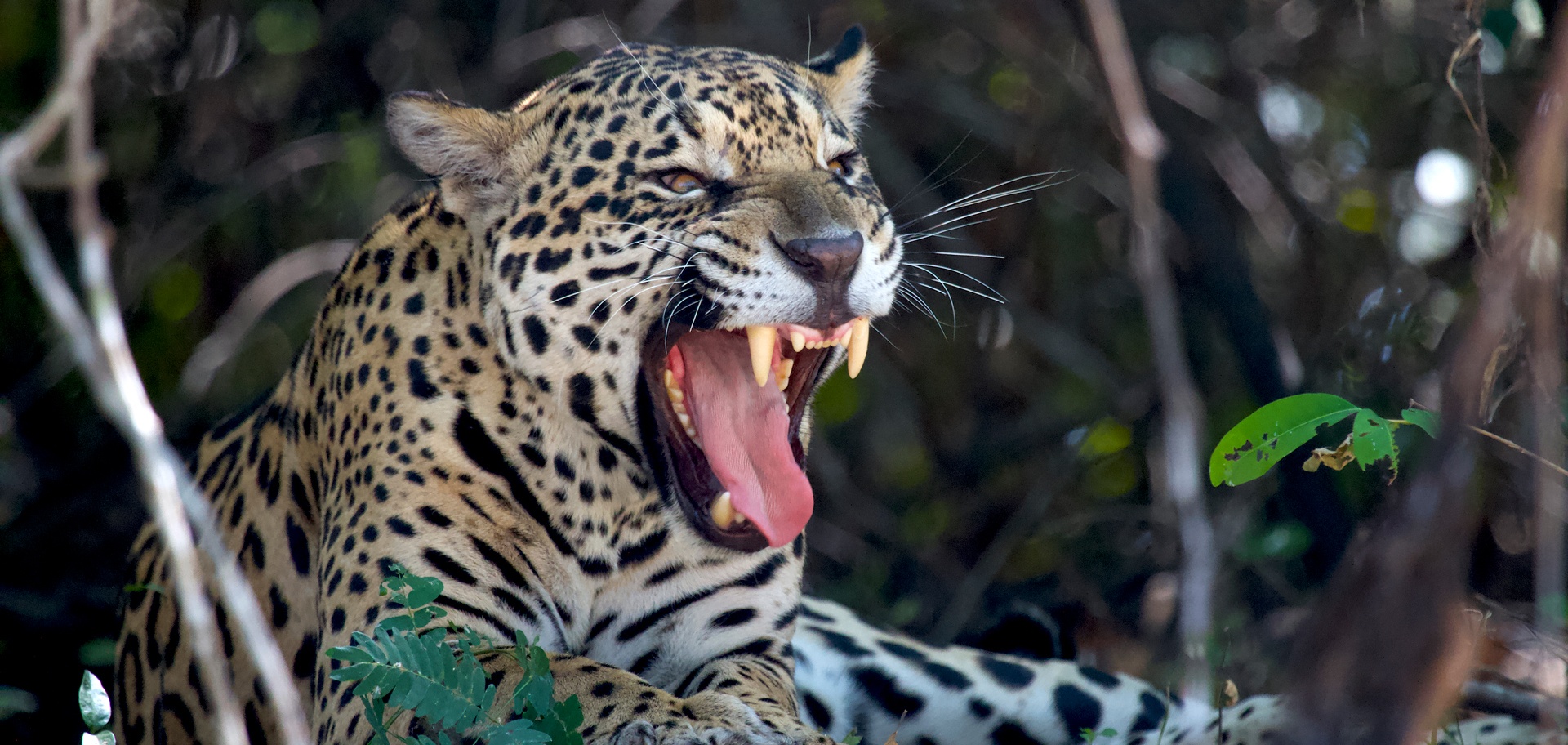
©Helder Brandao de Oliveira
Of the estimated 15,000 to 64,000 jaguars remaining in the wild, more than half of them live within the Amazon Rainforest and the Pantanal. About 60 to 80 jaguars of these reside inside the 204-square-mile Caiman Ecological Refuge, a renowned private reserve that happens to be the site of our spacious lodge, as well as Pantanal’s Onçafari jaguar team and scientific research center. Here, the project’s team members are constantly evaluating the health of the felines and monitoring their behavior through motion sensor cameras, direct observation, and a handful of GPS-equipped radio collars that can map their locations through different frequencies. But of the five jaguars that we end up spotting over the course of two days (with names like Timbo, Aroeira, Hades and Flor), only one of them has been collared to provide Onçafari with its coordinates. The other sightings are merely a testament to how well the jaguar habituation program is working.
According to Onçafari, only 16% of guests at the Caiman Ecological Refuge reported seeing jaguars in 2013. Ten years later, the percentage was 100. Although Onçafari never guarantees a sighting, the likelihood of spotting a jaguar (or jaguars) here really is possibly the best on the planet.
After about 40 minutes in Aracy’s presence, it’s time to move on. But before starting up our 4×4 vehicle’s engine, Morgado clears his throat. It’s a way to indicate to the felines that there’s a louder sound coming and remind these big cats that they can keep on keeping on without ever feeling threatened.
Natural Habitat Adventures’ Jaguars & Wildlife of Brazil’s Pantanal includes a few nights lodging at the Caiman Ecological Refuge and time spent with the Onçafari Jaguar Project, as well as one of the reserve’s spectacular Pantaneiro cowboy dinners—complete with an array of spit-roasted meat. Participants also have an opportunity to spot jaguars in the northern Pantanal and see other species like toucans, howler monkeys, giant armadillos and big-headed swamp turtles. Want to make your experience even more amazing? Tack on a trip extension to see one of the world’s mightiest waterfalls, the more-than-mile-long Iguazu Falls, straddling the border between Brazil and Argentina.
The post Tracking Jaguars with the Onçafari Project: Conservation Travel in Brazil’s Pantanal first appeared on Good Nature Travel Blog.